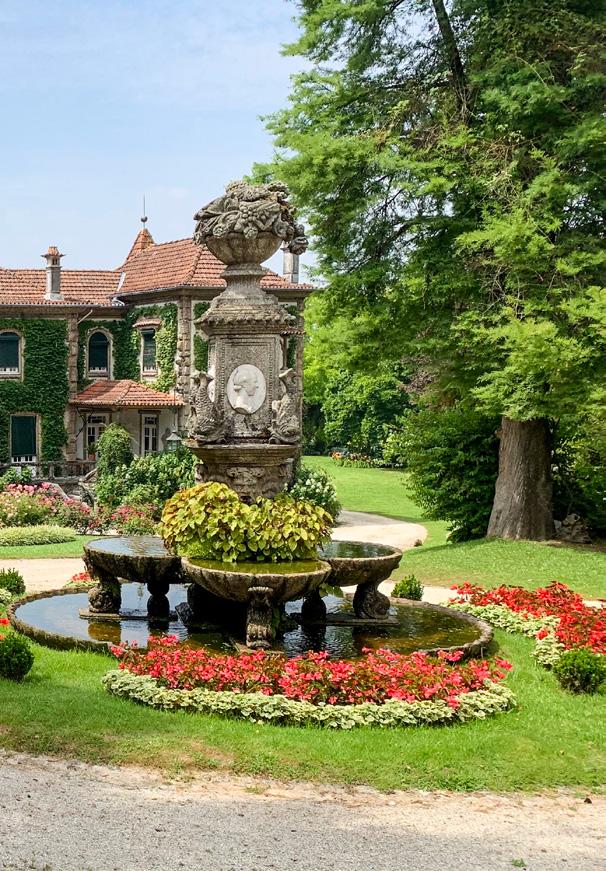
4 minute read
Family Connections
Connections Family
By Emma Yardley
A river cruise along Portugal’s Douro River provides a platform for this writer to connect with her family’s past and create new memories for the future.
Thanks to my mom, I’ve always known that obrigada is how women say thank you in Portuguese. Despite being an Anglo-Canadian girl growing up in rural B.C., I also knew that azulejos are multi-coloured, heat-reducing tiles that cover so many Portuguese buildings, and that port is a fortified wine produced in the Douro Valley and served in small glasses.

THE DOURO RIVER, PORTO PORTUGAL
When my mother left her English convent school in 1961, for six months, she lived with the Guedes family on their centuries-old estate, Quinta da Aveleda, just outside of Porto. She was there to help their two daughters, Teresa and Luisa, with their English; the Guedes girls, in return, would share their life with her in northern Portugal.
While not much official teaching went on, the cultural exchange forged my mother’s strong connection to the country, which she passed down to me.
So, when I was checking my itinerary for Portugal’s River of Gold, a 10-day bus-and-boat tour by Viking Cruises, one optional tour jumped off the page: wine tasting at Quinta da Aveleda. I signed up immediately. Arriving in Porto is like stepping back in time.

DOURO RIVER REGION
While the Romans settled in the city giving it the name Portus Cale (beautiful port), it was the meteoritic rise of port-wine production in the early 1700s that gave Porto its still-standing-today maze of hilly cobblestone streets, massive riverside warehouses, and colourful, azulejo-covered homes, seemingly stacked one atop the other.
For over 1,500 years, the main avenue for moving goods from the fertile, wineproducing Douro Valley to the Atlantic was the Douro River.
Traditional, flatbottomed rabelo boats and their 12-man crews made the harrowing (often fatal) journey along the rife-with-rapids river, up until the mid 1960s when a new highway opened and a set of dams calmed the waters. A handful of these iconic boats still bob in the river on the city’s edge as a floating nod to the past.

AVELEDA HOUSE PORTUGAL ©EMMA YARDLEY
Our vessel, the state-of-the-art Viking Helgrim, is a far more modern (it launched in March 2019), but was also designed specifically for the Douro – its shallow hull and smaller size (it has 53 staterooms compared to 95 on other Viking Cruises river vessels) fits snugly into the river’s five locks and can nimbly navigate its sharp bends.
But before we head up the river into the Douro Valley, where dry terraced vineyards, lush riverside orange groves and olive plantations dominate the landscape, I have an estate to visit.
Just a 15-minute bus ride from Porto’s city centre and we’re already surrounded by vast green grapevines, orchards heavy with summer fruit, and lush deciduous forests. The gardens are breathtaking. Since the Guedes family founded the estate in 1671, they’ve been planning the space and adding species collected from their globetrotting travels, basing the main area on an 18th century English garden.

AVELEDA HOUSE PORTUGAL ©EMMA YARDLEY
“Even now, one of the older members of the family takes care of all the details,” says estate guide Renata Figueiredo. “It’s rare to find the same family taking care of it for 300 years.”
I think about how much time my mom spent wandering these paths, looking at these rows of English roses that, despite seeming out of place in Portugal, still somehow thrived. I also find out that Mom withheld some important facts.
The Guedes family, Sara Mello, our Viking Cruises host guide tells us, is “quite a rich and important wine family.” In fact, they produce one of the most popular wines of all time, Mateus Rosé, which sells around two million cases a year; in Portugal, they are considered close to royalty.

BELEM TOWER IN LISBON, PORTUGAL
Suddenly, my mom’s old stories make more sense: how she’d pick up the grandmother from her house by horse carriage to bring her to the Guedes family chapel for nightly mass, or how there were strict protocols on who sits, drinks, and eats when.
I wish I could tell her I saw the rambling stone house where she stayed, all covered in flowering vines and romantic balconies – but this trip is one she couldn’t make, having passed away two years ago. “You’re the first visitor I’ve had here that actually has a connection with the family,” says Mello. “Your mother would be thrilled that you’re here seeing this.” Mello has no idea just how right she is.

